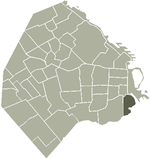La Boca
La Boca | |
|---|---|
Neighborhood of Buenos Aires | |
 Emblem[1] | |
 Location of La Boca within Buenos Aires | |
| Country | Argentina |
| Autonomous City | Buenos Aires |
| Comuna | C4 |
| Important sites | Caminito, La Bombonera, Estadio Alberto J. Armando |
| Area | |
| • Total | 3.3 km2 (1.3 sq mi) |
| Population (2001) | |
| • Total | 46,494 |
| • Density | 14,000/km2 (36,000/sq mi) |
| Time zone | UTC-3 (ART) |
La Boca (Spanish: [la ˈβoka]; "the Mouth", probably of Matanza)[2] is a neighborhood (barrio) of the Argentine capital, Buenos Aires. It retains a strong Italian flavour, with many of its early settlers being from the city of Genoa.
Geography[]
As one of Buenos Aires's 48 barrios, La Boca is located in the city's south-east near its old port. The barrio of Barracas is to the west; San Telmo and Puerto Madero are to the north.
History[]
In 1882, after a lengthy general strike, La Boca seceded from Argentina, and the rebels raised the Genoese flag, which was immediately torn down personally by then President Julio Argentino Roca.[3]
Among sports fans, Boca is best known for being the home of the world-renowned football club Boca Juniors. The club plays their home matches in Estadio Alberto J. Armando, popularly known as La Bombonera (Spanish for "the bonbon box").
La Boca is a popular destination for tourists visiting Argentina, with its colourful houses and pedestrian street, the Caminito, where tango artists perform and tango-related memorabilia is sold. Other attractions include the La Ribera theatre, many tango clubs and Italian taverns. The actual area visited by tourists is only a few blocks long and has been built up for tourism very actively over the last few years, with many market stalls and restaurants catering to tourists. Outside this tourist area, it is a fairly poor neighborhood that has had many regular occurrences of petty crimes reported.
It has also been a centre for radical politics, having elected the first socialist member of the Argentine Congress (Alfredo Palacios in 1935) and was home to many demonstrations during the crisis of 2001.
As of 2016, the health of over 1,000 La Boca citizens is threatened by the pollution of the Matanza-Riachuelo River (which contains high levels of arsenic and lead due to centuries of unstopped pollution).[4]
Gallery[]

Nineteenth century Ghost Tower, on Wenceslao Villafañe Street

The Caminito of tango lore, an example of the colour of La Boca attributable to local artist Benito Quinquela Martín

Brightly painted houses in Caminito

The riverwalk at the Rocha Bend of the Riachuelo

La Bombonera Stadium

The former Canale Biscuit Co. factory, now upscale lofts, La Boca.

Boca Juniors themed street vendor

Typical local street
References[]
- ^ "The emblems of the 48 barrios of Buenos Aires were presented" (Spanish) by ámbito.com August 29, 2011
- ^ "El Caminto, la Boca: Buenos Aires' Most Iconic, Colorful Street".
- ^ Wilson, Jason (1999). Buenos Aires: A Cultural and Literary Companion. Signal Books. p. 189. ISBN 1902669037. Retrieved 25 November 2018.
- ^ "The Mists of Riachuelo". ArgentinaIndependent.com. Argentina Independent. Retrieved 4 March 2016.
External links[]
| Wikimedia Commons has media related to La Boca, Buenos Aires. |
- A Flags of the World article about flags used in La Boca
- Caminito Street at La Boca neighbourhood
- A Brief Look into the History of La Boca
Coordinates: 34°38′08″S 58°21′53″W / 34.63556°S 58.36472°W
- European-Argentine culture in Buenos Aires
- Neighbourhoods of Buenos Aires
- Entertainment districts in Argentina
- Italian-Argentine culture









